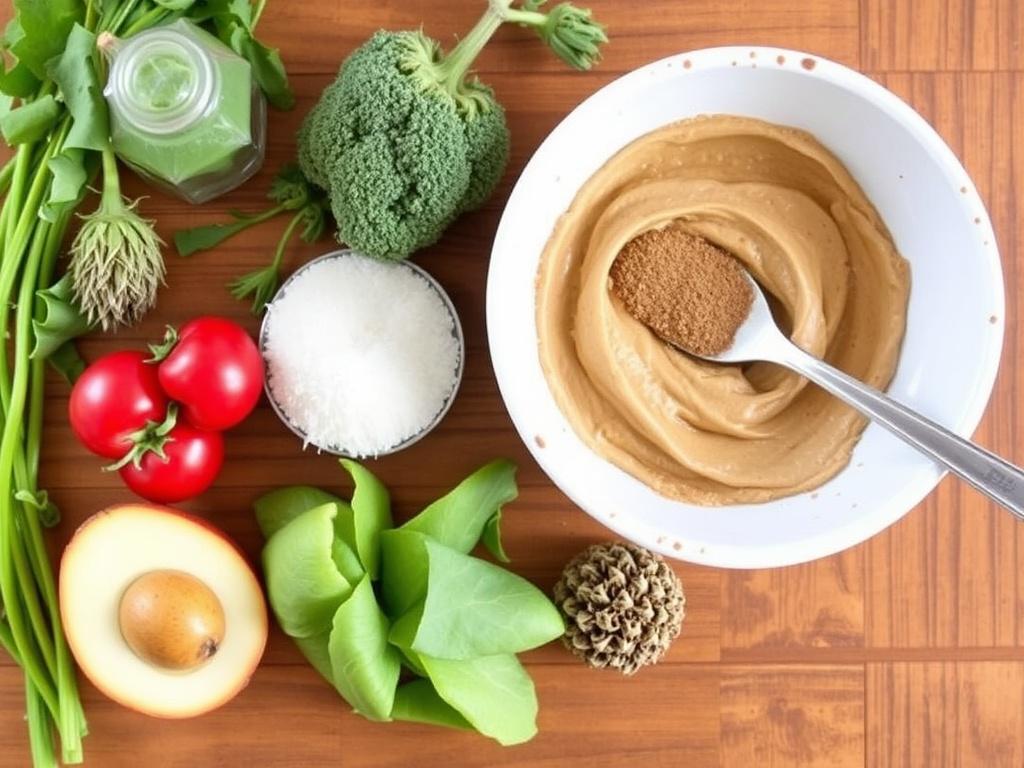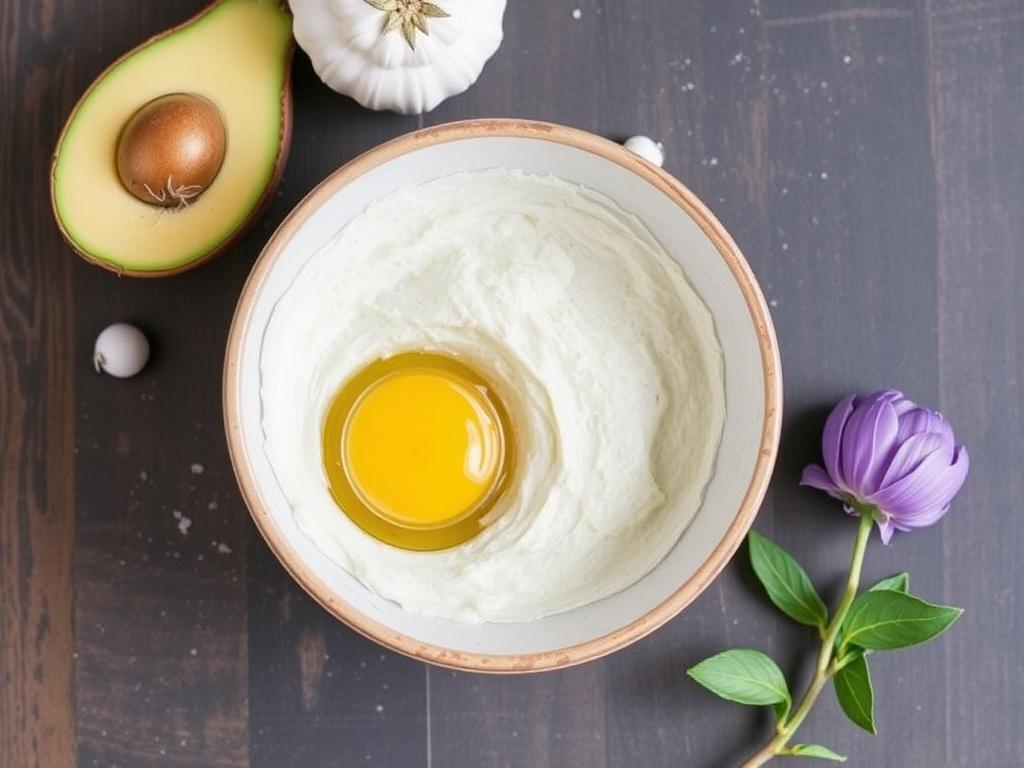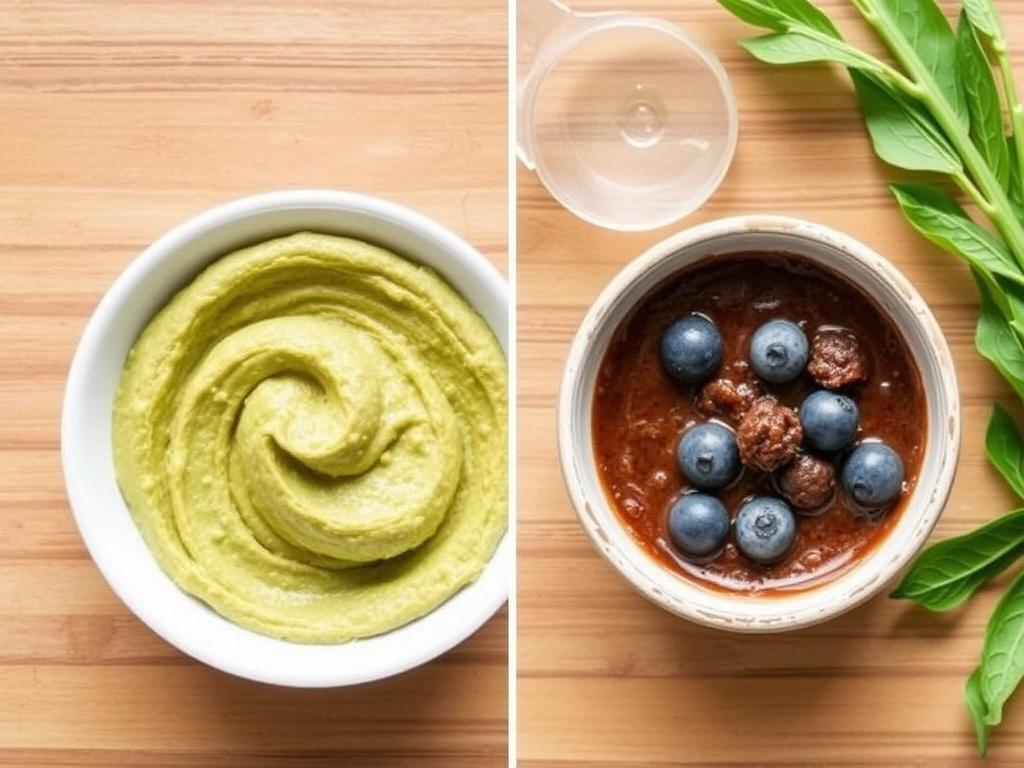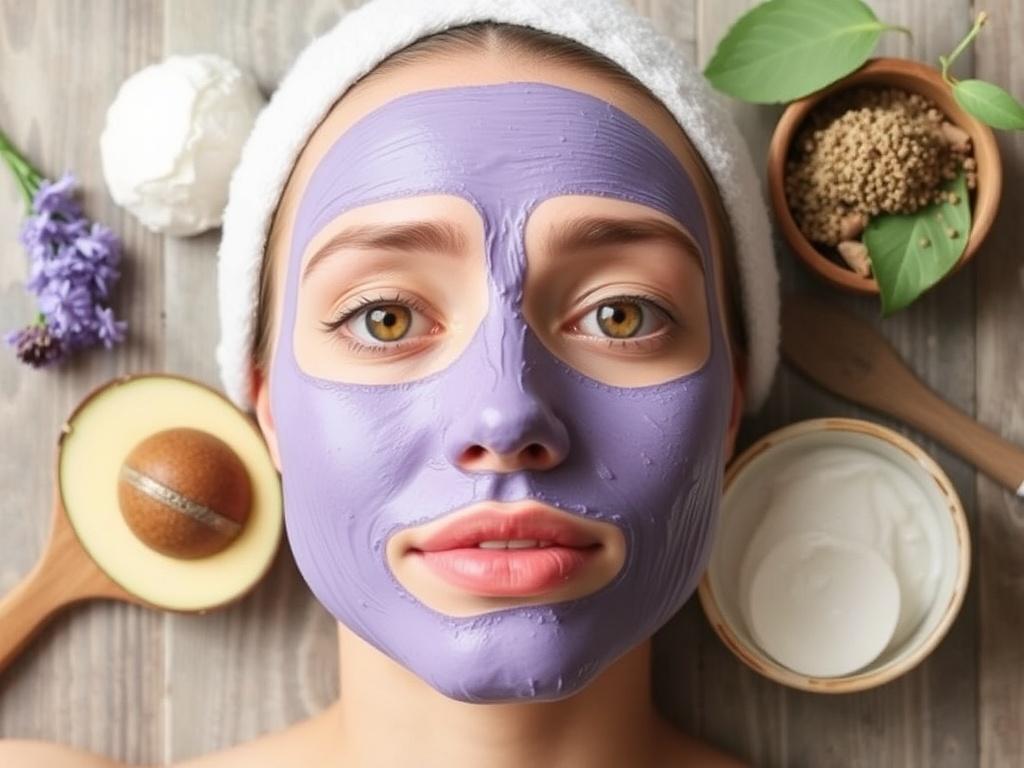SQLITE NOT INSTALLED
Imagine opening your pantry and finding secret beauty allies between the cereal boxes and cans of beans. That simple jar of honey, the yogurt tucked in the back, the ripe avocado on the counter — all of these are waiting to become nourishing, effective mascarillas caseras con ingredientes de tu despensa. In this article I’ll walk you through approachable recipes, gentle science-backed explanations, and practical tips so you can confidently make and use homemade face masks that suit your skin and your schedule.
This is not about trendy, exotic ingredients or expensive boutique skincare. It’s about making thoughtful, deliciously simple masks using what you already have. Whether you’re craving hydration, looking to soothe irritation, fighting shine, or simply indulging in a small ritual of self-care, these recipes and guidelines will help you craft personalized care from your pantry. You’ll learn how ingredients behave on your skin, how to mix and store them safely, and when to skip an experiment and see a professional.
Before we dive into recipes and instructions, let’s make one thing clear: mascarillas caseras con ingredientes de tu despensa can be wonderfully effective, but they’re not miracle cures. They can complement good skincare habits, provide short-term benefits, and give you a pleasant ritual. Throughout this guide I’ll balance enthusiasm with caution, offering ways to test for sensitivities and avoid common mistakes so your homemade mask adventures stay fun and safe.
Why Choose Homemade Masks from Your Pantry?
There’s a deep satisfaction in creating something nurturing from simple staples, and making your own face masks is no different. When you use mascarillas caseras con ingredientes de tu despensa, you take control over what touches your skin: no hidden preservatives, no surprise additives. This transparency is especially appealing if you have sensitivities or prefer minimal, recognizable ingredient lists. It’s also a creative process that turns ordinary food into a little act of self-care.
Practicality is another big advantage. Pantry ingredients are usually inexpensive and accessible, so you can try several recipes without committing to costly products. If you’re on a budget, these masks allow you to maintain a skincare routine that’s both effective and economical. Plus, many of the ingredients have been used traditionally for centuries — honey as a humectant and mild antimicrobial, oatmeal as a soothing cleanser, yogurt for gentle lactic acid exfoliation — and modern research often backs up these traditional uses.
Finally, making your own masks encourages experimentation and personalization. Skin is not one-size-fits-all, and what works for one person may irritate another. Starting with small batches of mascarillas caseras con ingredientes de tu despensa lets you tweak textures, concentrations, and application times until you find the perfect fit. You’ll learn what your skin loves and what to avoid, and the payoff is a skincare ritual that feels intimate, affordable, and effective.
Before You Start: Safety, Patch Tests, and Essentials
Even the gentlest pantry items can irritate some skin types, so safety should be your first priority. Before applying any new mascarilla casera con ingredientes de tu despensa to your face, perform a patch test: mix the mask, apply a small amount to the inside of your wrist or behind your ear, and wait 24 hours. If you notice redness, itching, swelling, or burning, don’t use that mixture on your face. This step is simple but can prevent uncomfortable reactions and is especially important if you have a history of allergies or very sensitive skin.
Another important safety tip concerns citrus and acids. Lemon and other citrus juices can cause photosensitivity and irritation, particularly if applied in high concentrations or left on the skin for too long. If you use masks containing lemon or other acids (like apple cider vinegar), use them sparingly, dilute appropriately, and always avoid sun exposure or use effective sunscreen afterward. Similarly, ingredients like cinnamon and baking soda can be too abrasive or irritating for some. Use them cautiously and avoid them if you have rosacea, open wounds, or compromised skin barriers.
Finally, clean tools and proper storage matter. Use a non-reactive bowl (glass, ceramic, or stainless steel), clean utensils, and freshly washed hands to mix masks. If you’re saving a small batch, store it in a sealed container in the fridge and use it within a day or two — many homemade masks don’t contain preservatives, so they can spoil faster than commercial products. Below I’ll give a more detailed table of ingredient behavior and shelf life so you can plan safely.
Pantry Ingredients and What They Do

Let’s get acquainted with common pantry ingredients and their skincare properties. Thinking of each ingredient in terms of what it brings — moisture, gentle exfoliation, oil control, soothing, or brightening — helps you pair them intelligently. Below is a practical table summarizing popular items, their benefits, and cautions so you can mix and match with confidence when making mascarillas caseras con ingredientes de tu despensa.
| Ingredient | Primary Benefits | Best For | Cautions |
|---|---|---|---|
| Honey (raw) | Humectant, mild antimicrobial, soothing | Dry, acne-prone, sensitive (if raw and mild) | Sticky texture; not a substitute for medical treatment |
| Yogurt (plain) | Gentle lactic acid exfoliation, moisturizing | Dry, combination, brightening needs | Avoid if severely dairy-sensitive |
| Oatmeal (ground) | Soothing, anti-inflammatory, gentle exfoliant | Sensitive, eczema-prone, dehydrated | Use finely ground for comfort |
| Olive oil / Coconut oil | Deep moisturizing, occlusive | Very dry skin, body masks, hair | Can clog pores for acne-prone skin; coconut oil can be comedogenic |
| Avocado / Banana | Hydration, vitamins, creamy texture | Dry or mature skin | Freshness matters; avoid if allergic to fruits |
| Egg (white / yolk) | Protein for tightening (white), lipids for moisturizing (yolk) | Oily skin (white), dry skin (yolk) | Avoid if allergic; raw egg on skin OK but avoid near broken skin |
| Sugar / Salt | Physical exfoliant | Normal, oily (use sugar), body exfoliation | Abrasive on delicate facial skin if used too harshly |
| Coffee grounds | Exfoliating, circulation boost, antioxidant | Cellulite-targeted body scrubs, brightening eyes | Can stain; gritty texture |
| Cinnamon / Turmeric | Anti-inflammatory, brightening (turmeric), circulation (cinnamon) | Spot-brightening, dullness | Cinnamon can irritate; turmeric can stain skin and fabrics |
| Lemon / Apple Cider Vinegar | Acidic exfoliation, brightening | Oily, hyperpigmented areas (with caution) | Highly irritating if undiluted; photosensitizing |
| Aloe vera | Soothing, hydrating, anti-inflammatory | Sensitive, sun-exposed skin | Some people may be allergic; use patch test |
| Milk / Buttermilk | Gentle lactic acid exfoliant, moisturizing | Sensitive, dry skin | Spoils quickly; refrigerate |
| Baking soda | Alkaline exfoliant, can neutralize odors | Occasional exfoliation for oily skin | Overuse can disrupt skin pH and barrier |
This table is a quick cheat sheet when you want to assemble a mask on the fly. For example, honey plus yogurt gives you moisture plus gentle acid exfoliation, while oatmeal and aloe vera pair beautifully for a calming mask. Some ingredients are multipurpose — honey appears repeatedly because it hydrates, helps heal, and adds a smooth texture. Keep in mind the cautions listed here, particularly with ingredients that can be harsh or stain.
When planning mascarillas caseras con ingredientes de tu despensa, think of ingredients as “roles” rather than strict recipes. Each mask should have a base (a creamy or powdery vehicle), an active (exfoliant, brightener, or anti-inflammatory), and an optional booster (like a few drops of oil or a sprinkle of spice). This flexible mental model helps you adapt to what you have and avoid combinations that might be irritating or ineffective.
Tools and Containers You’ll Need
You don’t need fancy equipment to make effective mascarillas caseras con ingredientes de tu despensa, but having a few basic tools makes the process cleaner and easier. A small glass mixing bowl, a ceramic spoon or spatula, measuring spoons, a fine mesh sieve for grinding and straining, and airtight glass jars for storage will cover most needs. Glass and ceramic are preferable to plastic because they don’t react with acidic ingredients and are easier to sanitize.
Also consider keeping a small hand towel, a headband to keep hair back, and a soft washcloth for removal. If you like a spa-like finish, a warm washcloth used to steam off the mask feels wonderful — but be gentle, especially after masks that exfoliate. Finally, a notebook or phone note is useful to record recipes that work well for your skin so you can refine them over time. This ritual of careful preparation and documentation is part of the joy of creating mascarillas caseras con ingredientes de tu despensa.
Moisturizing Masks: Recipes for Dry or Dehydrated Skin
Dry or dehydrated skin craves both hydration (water-binding ingredients) and nourishment (oils and emollients). The best mascarillas caseras con ingredientes de tu despensa for dry skin combine humectants like honey or glycerin (if you have it) with occlusives like olive oil or avocado to lock moisture in. Below are several deeply moisturizing recipes that are gentle and effective.
These masks are intentionally rich, so they work well as an occasional overnight treatment or as a 15–30 minute pampering session. If you plan to sleep with a mask, avoid heavy, pore-clogging oils if you are prone to breakouts. Use clean bedding and a towel to prevent staining, and always do a patch test first if you haven’t used the ingredients before.
1) Honey + Yogurt Hydration Mask
This is a classic for a reason: yogurt brings gentle lactic acid exfoliation while honey attracts and retains moisture. The texture is smooth and cooling, making it perfect for a midday pick-me-up or a pre-bedtime ritual. It helps plump surface lines and leaves skin feeling soft to the touch.
Ingredients:
- 1 tablespoon plain yogurt (full-fat is lush)
- 1 teaspoon raw honey
- Optional: 1 teaspoon mashed avocado for extra richness
Directions:
- Mix yogurt and honey in a clean bowl until smooth.
- If using avocado, fold it in and mash thoroughly for an even texture.
- Apply a thin, even layer to clean skin and relax for 15–20 minutes.
- Rinse gently with lukewarm water and pat dry. Follow with your moisturizer.
Why it works: The lactic acid in yogurt exfoliates gently without stripping, allowing the honey to penetrate and lock in moisture. This combination supports the skin’s natural barrier and is forgiving for sensitive or fatigued skin. Use once or twice weekly for best results.
2) Avocado + Olive Oil Soothing Mask
Avocado is rich in fatty acids and vitamins A and E, while olive oil adds deep emollience. This is a decadent, nourishing mask that feels like a mini facial. It’s particularly helpful in cold, dry weather or during periods when skin feels tight and flaky.
Ingredients:
- Half a ripe avocado
- 1 teaspoon olive oil (extra virgin is fine)
- Optional: 1 teaspoon honey for humectant action
Directions:
- Mash the avocado until creamy and free of lumps that could irritate skin.
- Stir in olive oil and honey, if using, to achieve a spreadable consistency.
- Apply a layer to clean skin and leave on for 15–25 minutes.
- Rinse with lukewarm water and finish with your moisturizer.
Why it works: The avocado and olive oil help replenish lipids and fatty acids, strengthening the skin barrier. Adding honey increases hydration. Keep this mask to short sessions if you are prone to clogged pores, and always rinse thoroughly.
3) Banana + Oatmeal Comfort Mask
Banana is soothing and contains potassium and vitamins that support skin health. Ground oatmeal calms inflammation and forms a gentle paste that cleanses as it hydrates. This mask is forgiving and ideal for mornings when your skin feels sensitive and dull.
Ingredients:
- Half a ripe banana, mashed
- 2 tablespoons finely ground oatmeal (blend to a powder)
- 1 teaspoon honey or a splash of milk for texture
Directions:
- Combine mashed banana with oatmeal and honey or milk until it forms a spreadable paste.
- Apply to clean skin and relax for 10–15 minutes (banana can darken if left too long).
- Gently rinse with warm water using fingers in circular motions for a mild massage.
Why it works: Oatmeal soothes and creates a gentle exfoliant, while banana moisturizes and provides mild brightening. It’s mild enough for regular use and especially soothing after a long day or if your skin feels itchy from dryness.
Balancing and Oil-Controlling Masks for Oily or Combination Skin
When your skin leans oily or combination, you want masks that absorb excess oil, refine texture, and reduce shine without excessively stripping the skin. Many mascarillas caseras con ingredientes de tu despensa for oily skin include clay (if you have cosmetic clay), egg whites, yogurt, or ingredients like lemon and baking soda used cautiously. Focus on short application times and rinse thoroughly to avoid over-drying.
Below are approachable recipes that bring balance and a fresh, matte finish. Use them once or twice a week and follow with a light moisturizer to prevent rebound oiliness.
1) Egg White + Oatmeal Tightening Mask
Egg white is a classic for tightening the appearance of pores and giving a temporary firm feeling. Combined with oatmeal for soothing, it’s a good option for oily areas. If you’re using egg white, avoid it on irritated or broken skin, and consider doing a patch test first.
Ingredients:
- 1 egg white (separated from the yolk)
- 1 tablespoon finely ground oatmeal
- Optional: a few drops of lemon juice (use with caution; dilute)
Directions:
- Whisk the egg white until a bit frothy, then fold in the oatmeal.
- Apply a thin layer, concentrating on the T-zone or oily areas.
- Leave on for 10–15 minutes, then rinse with cool water and pat dry.
Why it works: The proteins in egg white create a temporary tightening effect, while oatmeal soothes and prevents irritation. Be mindful of oil rebound and always moisturize lightly afterward.
2) Yogurt + Lemon Clay-Style Mask (Use Sparingly)
This mask merges yogurt’s gentle exfoliating acids and lemon’s astringent properties to reduce oiliness and brighten. Because lemon can be irritating and photosensitizing, dilute it and use only briefly in the evening, followed by sunscreen the next day if you’re going outside.
Ingredients:
- 2 tablespoons plain yogurt
- 1/2 teaspoon lemon juice (diluted further if sensitive)
- Optional: 1 teaspoon ground oats to thicken
Directions:
- Mix yogurt and lemon juice, adding oats if needed for texture.
- Apply for 8–10 minutes only, then rinse thoroughly.
- Use once a week and stop if your skin becomes red or tight.
Why it works: Yogurt provides mild lactic acid exfoliation and hydration; lemon acts as an astringent and mild brightener. Keep the exposure brief to avoid irritation and always follow up with gentle care.
3) Coffee Grounds + Honey Exfoliating Mask
Used coffee grounds are both economical and effective as a physical exfoliant. Mixed with honey they create a balancing mask that removes surface oil and invigorates circulation. This is especially nice in the mornings or before special events when you want immediate freshness.
Ingredients:
- 1 tablespoon used coffee grounds (cooled)
- 1 teaspoon honey
- Optional: 1 teaspoon yogurt for extra balance
Directions:
- Combine coffee grounds and honey to form a paste; add yogurt if you like.
- Apply in gentle circular motions, massaging for 30–60 seconds to exfoliate.
- Leave on for 5–10 minutes and rinse with warm water until all grounds are removed.
Why it works: Coffee stimulates microcirculation and acts as a gentle scrub, while honey aids in moisture balance and provides mild antibacterial benefits. Avoid aggressive scrubbing; let the texture do the work to prevent microtears in your skin.
Brightening and Exfoliating Masks
When your skin looks dull or pigmentation is a concern, mild exfoliation and brightening ingredients can help even skin tone and add radiance. Many pantry ingredients offer enzymatic or acidic exfoliation that is gentler than harsh commercial acids when used correctly. Again, caution with citrus and powdered spices is key — always patch test and avoid overuse.
Here are masks focused on gentle resurfacing and natural brightening, suitable for occasional use (typically once per week) to reveal fresher skin.
1) Turmeric + Yogurt Brightening Mask
Turmeric contains curcumin, which has anti-inflammatory and antioxidant properties. Combined with yogurt for lactic acid action, this mask can help brighten and calm irritated, dull skin. Note that turmeric can temporarily tint the skin yellow or stain fabrics, so use it when you can take it slow and rinse well.
Ingredients:
- 1 teaspoon turmeric powder
- 1 tablespoon plain yogurt
- 1 teaspoon honey (optional)
Directions:
- Mix turmeric thoroughly into yogurt until smooth. Add honey if desired.
- Apply a thin layer to the face and leave for 10 minutes.
- Rinse well with lukewarm water, using a washcloth if needed to remove any residue.
Why it works: The combination soothes and exfoliates mildly while delivering antioxidant support. Use sparingly and always check for any staining on towels or clothing; dilute turmeric if you’re concerned about marks.
2) Papaya or Pineapple Enzyme Mask
Papaya and pineapple contain natural enzymes (papain and bromelain) that provide gentle enzymatic exfoliation. These fruit masks can soften keratinized skin and brighten without abrasive scrubs. They’re especially useful for sloughing off rough patches on elbows or dry facial areas, but proceed cautiously if you have sensitive skin.
Ingredients:
- 2 tablespoons ripe papaya or pineapple, mashed
- 1 teaspoon honey or yogurt for texture
Directions:
- Puree the fruit until very smooth to avoid chunks that could irritate.
- Mix with honey or yogurt and apply for 5–10 minutes only.
- Rinse thoroughly; avoid prolonged exposure as enzymes are potent.
Why it works: Enzymes break down dead skin cells gently, offering radiant results with minimal mechanical friction. Always limit exposure if your skin is thin or reactive.
3) Sugar + Lemon Micro-Polish (For Occasional Use)
A quick sugar scrub with a drop of lemon can brighten by physically polishing the surface and applying a mild acid. Because of the lemon and the physical exfoliation, this is an occasional treatment. Use it before an event when you want a quick glow, but avoid it if you’re using retinoids or other skin-sensitizing actives.
Ingredients:
- 1 tablespoon fine sugar
- 1 teaspoon olive oil or honey
- 1/4 teaspoon lemon juice (diluted)
Directions:
- Mix sugar and oil to form a paste, then add lemon juice.
- Massage gently on damp skin for 30–60 seconds and rinse with lukewarm water.
- Follow with a gentle moisturizer; avoid sun exposure right after.
Why it works: The sugar provides physical exfoliation while lemon offers light brightening. Do not overdo it — mildness and frequency are what keep this ritual beneficial rather than damaging.
Soothing Masks for Sensitive or Reactive Skin

Sensitive skin needs anti-inflammatory, gentle ingredients that calm redness and support barrier repair. Mascarillas caseras con ingredientes de tu despensa for sensitive skin should avoid strong acids, spicy powders, and aggressive scrubs. Instead, focus on oatmeal, aloe vera, cooled chamomile tea, and pureed cucumber. These materials soothe, hydrate, and reduce visible irritation.
Laid-back, low-ingredient masks work best here: the fewer moving parts, the less chance of a reaction. Below are calming recipes that feel comforting and are easy to prepare.
1) Oatmeal + Aloe Vera Calming Mask
Oatmeal is a top pantry comfort food for sensitive skin — it is colloidal when ground and has anti-irritant properties. Coupled with aloe vera, this mask reduces inflammation and restores comfort to irritated skin. It’s ideal after sun exposure, shaving, or any event that leaves your skin tight.
Ingredients:
- 2 tablespoons finely ground oatmeal
- 1–2 tablespoons pure aloe vera gel
- Optional: a few drops of cooled chamomile tea
Directions:
- Mix oatmeal with aloe vera to create a soothing paste.
- Apply for 10–15 minutes and rinse gently with lukewarm water.
- Pat dry and apply a fragrance-free moisturizer.
Why it works: Oatmeal binds to irritants and helps relieve itchiness, while aloe lowers inflammation and hydrates. This one is forgiving and safe for most skin types, though a patch test is still recommended.
2) Cucumber + Yogurt Refreshing Mask
Cucumber is cooling and hydrating, and yogurt gives a gentle lactic acid boost without aggression. The result is a refreshing, quick mask that calms puffiness and leaves skin feeling restored.
Ingredients:
- 2 tablespoons cucumber puree (blended and strained)
- 1 tablespoon plain yogurt
- Optional: 1 teaspoon aloe vera for extra calm
Directions:
- Blend cucumber until smooth and strain if you prefer a smoother texture.
- Mix with yogurt and aloe vera and apply for 10–15 minutes.
- Rinse gently and pat dry.
Why it works: The cooling effect and moisture content of cucumber combined with yogurt’s gentle exfoliation make this mask excellent for quick relief and hydration. Keep application times moderate to avoid over-exfoliation.
Acne-Prone and Spot Treatments
Treating acne-prone skin with mascarillas caseras con ingredientes de tu despensa requires a gentle hand. Look for ingredients with mild antimicrobial properties (like honey), anti-inflammatory actions (like turmeric), and oil-absorbing qualities (like clay or coffee). Avoid heavy oils unless your skin tolerates them, and skip abrasive scrubs that can worsen inflammation. Treat spot areas with targeted, brief applications rather than slathering harsh ingredients across the whole face.
Below are targeted masks and spot treatments to help reduce inflammation and support clearer-looking skin. Remember, persistent or severe acne should be evaluated by a dermatologist; these home recipes can help mild breakouts and complement professional care.
1) Honey + Cinnamon Spot Paste (Use Very Carefully)
Honey provides mild antibacterial properties, and cinnamon can improve circulation, which some people find helpful for spot treatment. However, cinnamon can be a potent irritant and must be used sparingly and only for short, targeted applications. Avoid this combination if you have sensitive or inflamed skin.
Ingredients:
- 1/2 teaspoon honey
- Pinch of cinnamon powder
Directions:
- Mix honey and cinnamon into a tiny paste and apply a dab directly to a pimple for 10–15 minutes.
- Rinse thoroughly and monitor for irritation. Use no more than once or twice a week.
Why it works: Honey’s antibacterial action helps reduce bacteria on the surface, and cinnamon can stimulate circulation, but the risk of irritation is real. If you experience burning or redness, remove immediately and do not repeat.
2) Apple Cider Vinegar Toner-Style Mask (Diluted)
Apple cider vinegar (ACV) has acetic acid which can balance pH and exhibit antimicrobial properties when used properly diluted. It should never be applied undiluted to facial skin. Use this as a very short-contact application or toner-like splash after patch testing carefully.
Ingredients:
- 1 part apple cider vinegar
- 3–5 parts water (adjust strength based on tolerance)
- Optional: a splash of green tea for antioxidants
Directions:
- Dilute ACV in water, apply briefly with a cotton pad to the affected area, and rinse off after 1–2 minutes if you prefer.
- Use sparingly and do not combine with retinoids or other acids without professional guidance.
Why it works: ACV can help rebalance surface microbes and pH but must be respected as a potent acid. Keep exposure brief, and always moisturize afterward. If you have sensitive skin, skip ACV altogether.
How to Prepare and Apply Your Mask: A Step-by-Step Ritual
Creating a simple ritual around your mascarillas caseras con ingredientes de tu despensa increases their effectiveness and your enjoyment. A peaceful, steady routine helps ingredients penetrate and reduces the temptation to leave masks on too long. Below is a step-by-step guide to help your masks perform their best.
Think of this as a mini facial: cleansing, warm prepping, applying the mask, gentle removal, and finishing with hydration. The quality of your results often depends more on consistent gentle care than any single “magic” ingredient.
- Step 1: Start with clean skin. Remove makeup and surface oils with a gentle cleanser. Homemade masks work best on a slightly damp, clean canvas so they can adhere evenly and penetrate.
- Step 2: Use a warm compress or steam (optional). A quick facial steam over a bowl of hot water, covered with a towel for 2–4 minutes, softens skin and opens pores, helping actives work better. Skip this if your skin is inflamed or rosacea-prone.
- Step 3: Apply evenly with clean hands or a brush. Use a spatula or clean fingers to apply a thin, even layer. For spot treatments, use a cotton swab to apply tiny amounts directly where needed.
- Step 4: Time it properly. Stick to recommended times — usually 5–20 minutes depending on the mask. Overextending an active mask can cause irritation; more is not always better.
- Step 5: Remove gently. Rinse with lukewarm water, using soft circular motions if you want a little extra mechanical exfoliation. For soothing masks, cool water can help close pores and calm the skin.
- Step 6: Tone and hydrate. Pat dry and apply a gentle toner or hydrating mist if you like, followed by a lightweight moisturizer appropriate for your skin type. Sealing with an oil or cream helps lock in benefits from moisturizing masks.
Keeping a small ritual like this helps you avoid common mistakes — like leaving lemon-based masks on too long or skipping moisturizer after a clay mask. It also makes the experience relaxing, transforming a practical skincare step into a mindful break in your day.
Storage, Shelf Life, and Food Safety
One of the realities of mascarillas caseras con ingredientes de tu despensa is that they often lack preservatives. That means they can spoil or grow bacteria faster than commercial products. A few smart storage practices will keep your masks safe and effective.
Here’s a quick table summarizing typical storage advice and expected lifespan for common homemade mask components and finished mixes. Use it as a reference when you plan a week of pampering or just a single mask session.
| Ingredient / Mix | Storage | Approximate Shelf Life | Notes |
|---|---|---|---|
| Raw honey (pure) | Pantry, sealed | Indefinite if pure | Does not spoil easily; crystals are normal |
| Plain yogurt | Refrigerated | 7–14 days unopened; 3–5 days after opening | Spoils quickly; don’t keep masks with yogurt longer than 24–48 hours |
| Avocado, banana (mashed) | Refrigerated in airtight container | 24–48 hours | Oxidizes and can grow bacteria; use quickly |
| Prepared mask with dairy/fruit | Refrigerate | 24–48 hours max | Best to make fresh for each use |
| Oatmeal paste | Refrigerate | 2–3 days | Check for off smell or separation |
| Oil-based mixes (olive, coconut) | Pantry in cool dark place | Weeks to months depending on oil | Can last longer; watch for rancid smell |
| Mask with egg | Use immediately | Do not store; discard leftovers | Eggs can harbor bacteria; prepare fresh |
| Tea or aloe vera mixes | Refrigerate | 2–3 days | Store in airtight container |
As a rule of thumb, plan to make masks in small batches and use them immediately or within 24–48 hours if refrigerated. Avoid double-dipping with fingers when you plan to store leftover masks; instead, use a clean spatula to portion into a sealed container. Discard leftovers if you notice a sour smell, discoloration, or any texture changes. These signs often indicate spoilage.
Food safety also matters in ingredient selection. If you’re concerned about immune issues or have broken skin, avoid raw eggs or ingredients that might introduce pathogens. For most healthy people, topical application of common pantry items is fine, but exercising caution and respecting storage guidelines keeps the experience pleasant and safe.
Troubleshooting: Redness, Burning, and When to Stop
If your skin reacts — redness, intense burning, stinging, swelling — remove the mask immediately and rinse with cool water. Do not apply oils or heavy creams to calm a chemical burn or rash; soothing with cool water and consulting a healthcare professional is the safest path. For minor irritation that subsides quickly, avoid the offending ingredient in future mascarillas caseras con ingredientes de tu despensa.
Here are common issues and simple fixes:
- Mild redness or warmth: Rinse off the mask and apply a soothing ingredient like aloe vera or a fragrance-free moisturizer. Avoid further active ingredients for several days.
- Burning or stinging: Immediately rinse with cool water. Apply a thin layer of aloe vera or a cold compress. If the sensation is severe or persists, consult a healthcare professional.
- Patches of dryness after an exfoliating mask: Hydrate with a gentle occlusive like a light oil or cream. Reduce exfoliation frequency and use milder formulas.
- Staining from turmeric: Use a gentle cleanser and a milk compress; repeat if needed. Turmeric stains are temporary but persistent; avoid white towels!
Long-term irritation or recurring breakouts after using a particular ingredient should prompt you to discontinue that ingredient and, if necessary, seek advice from a dermatologist. Homemade masks can be delightful, but your skin’s health is paramount. If you develop blisters, extensive swelling, or any signs of infection, get professional help promptly.
Extras: Combining Masks with Simple Home Treatments

To maximize the benefits of mascarillas caseras con ingredientes de tu despensa, consider pairing masks with gentle, complementary treatments. These are low-cost additions that elevate a mask into a relaxed home spa experience and can boost results when done sensibly.
Helpful additions include:
- Green tea toner: Brewed and cooled green tea is an antioxidant-rich toner that soothes and refreshes. Apply with a cotton pad after rinsing a mask.
- Face steam: A short 2–4 minute steam before applying a mask can help with product penetration. Avoid steam if your skin is reactive or rosacea-prone.
- Cold compress: Use chilled cucumber slices or a cold washcloth after a brightening mask to minimize redness and close pores.
- Gentle massage: A soft upward massage with fingertips while applying a moisturizing mask encourages lymphatic flow and relaxation. Avoid massaging inflamed skin.
These small rituals not only support the mask’s effects but also make the whole experience more restorative. Part of the appeal of mascarillas caseras con ingredientes de tu despensa is that they turn an errand — caring for your skin — into a mindful pause that benefits both appearance and mood.
Sustainable Beauty: Zero Waste and Cost Savings
Making masks from pantry ingredients is naturally sustainable in many ways. You reduce packaging waste by using items you already have, repurpose small leftovers (like mashed banana or a spoon of yogurt nearing expiration), and can avoid single-use wipes and plastic masks. With a little creativity, you can integrate beauty into a zero-waste lifestyle without missing out on results.
Here are practical sustainability tips:
- Compost used fruit and vegetable residues where possible rather than throwing them in the trash.
- Use reusable glass jars for storing small quantities and for mixing to avoid plastic waste.
- Plan recipes around what you need to use up in your kitchen—this reduces food waste and keeps ingredients fresh.
- Share recipes with friends so you can swap jars and try different combinations without buying lots of new ingredients.
From a cost perspective, homemade masks are often much cheaper than boutique masks. A jar of honey or a tub of yogurt will make many masks across months, translating to significant savings. When you invest a little time in learning which ingredients work best for you, you build a personalized, sustainable routine that feels luxurious without the financial or environmental cost of high-end products.
Quick Reference: Recipes at a Glance
When you want quick inspiration, a compact table of recipes and their ideal skin types is handy. Below is a quick reference chart for the recipes discussed earlier so you can choose the right mask without scrolling through long instructions.
| Recipe | Main Ingredient | Skin Type | Time |
|---|---|---|---|
| Honey + Yogurt Hydration | Yogurt + Honey | Dry, normal, sensitive | 15–20 min |
| Avocado + Olive Oil Soothing | Avocado | Very dry | 15–25 min |
| Banana + Oatmeal Comfort | Banana + Oatmeal | Dry, sensitive | 10–15 min |
| Egg White + Oatmeal Tightening | Egg white | Oily, combination | 10–15 min |
| Yogurt + Lemon Balance | Yogurt + Lemon | Oily (with caution) | 8–10 min |
| Coffee Grounds + Honey | Coffee | Oily, dull | 5–10 min |
| Turmeric + Yogurt Brightening | Turmeric | Dull, uneven | 10 min |
| Papaya Enzyme Mask | Papaya | Dull, rough | 5–10 min |
| Oatmeal + Aloe Vera Calming | Oatmeal + Aloe | Sensitive, reactive | 10–15 min |
| Cucumber + Yogurt Refresh | Cucumber | Sensitive, puffy | 10–15 min |
Use this table as a quick way to select a mask based on how your skin feels today. Keep a small index card or digital note with your favorite combinations and any tweaks that worked — this makes your mascarillas caseras con ingredientes de tu despensa a reliable part of your routine.
Frequently Asked Questions (FAQs)
Here are answers to some common questions people ask when they start experimenting with mascarillas caseras con ingredientes de tu despensa. These tips reflect practical experience and a cautious, skin-first approach.
Can I mix multiple active ingredients together?
Yes, but do so carefully. Combining two gentle actives (yogurt + honey) is usually fine, but mixing several potent actives (lemon + baking soda + turmeric) increases the risk of irritation. If you want to experiment, add one new ingredient at a time so you can isolate effects and patch test each combination.
How often should I use homemade masks?
Frequency depends on the mask. Soothing or moisturizing masks can be used 2–3 times weekly or even more often if they are gentle. Exfoliating or brightening masks should usually be limited to once weekly. Listen to your skin: if it becomes red, tight, or flaky, reduce frequency.
Are there ingredients I should avoid entirely?
Avoid undiluted strong acids (like straight lemon juice) and abrasive scrubs on fragile or inflamed skin. If you have rosacea, eczema, or very sensitive skin, skip cinnamon, baking soda, and harsh acids entirely. Always patch test and consult a professional if you’re unsure.
Can I use these masks if I’m on prescription topical treatments?
Be cautious. If you use retinoids, benzoyl peroxide, or other prescription topicals, they can increase sensitivity. Avoid strong exfoliants and acids while on these treatments without your provider’s guidance. When in doubt, ask your dermatologist how to safely integrate homemade masks into your prescription routine.
Do these masks help with aging skin?
Some masks with humectants (honey), antioxidants (green tea, turmeric), and gentle exfoliants (yogurt, papaya) can improve radiance and temporary smoothness. For deeper concerns like volume loss or persistent wrinkles, professional treatments and consistent medical-grade skincare may be needed. Homemade masks can complement those efforts by maintaining hydration and surface tone.
Final Thoughts and Encouragement
Mascarillas caseras con ingredientes de tu despensa are an invitation to play, care for yourself, and use simple, wholesome materials to support skin health. They’re flexible, budget-friendly, and emotionally rewarding. By learning which pantry ingredients suit your skin and using them with respect for safety and storage, you’ll create a small but powerful self-care habit.
Start small: test one recipe, note how your skin responds, and adjust. Keep it simple and build a short list of go-to masks that reliably make your skin look and feel better. Over time, you’ll develop a personalized repertoire that reflects both your lifestyle and your skin’s needs. Enjoy the process — there’s pleasure in turning everyday food into a ritual that nourishes both body and mind.
Above all, be gentle with your skin and yourself. Homemade masks are about care, not perfection. If you want a printable cheat sheet or a short list of three “always work” recipes tailored to your skin type, tell me your skin type and preferences and I’ll create it for you. Happy mixing — and cheers to finding beauty in the pantry.




